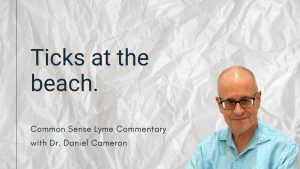Call for your appointment today 914-666-4665 | Mt. Kisco, New York

The 49-year old man had been diagnosed one month earlier with Lyme disease after testing positive and treated with a 10-day course of doxycycline.
He was an avid hiker who had frequented trails in Pennsylvania, wrote Palmer and colleagues in their article “Atrial Flutter and Left Hemidiaphragmatic Paralysis in the Setting of Lyme Disease.”¹
The man “overall felt better after taking the antibiotics,” however, he presented one month later with cardiac problems, including shortness of breath and chest pain, which had been ongoing for two weeks, wrote the authors.
He presented with shortness of breath and chest pain.
“He appeared in acute distress with tachypnea and tachycardia to 169 beats/minute but was not hypoxic,” the authors wrote.
An EKG showed atrial flutter with a rapid ventricular response. “Due to concern for Lyme carditis causing tachyarrhythmia, the patient was started on IV ceftriaxone,” the authors wrote.
In atrial flutter, the heart’s upper chambers (atria) beat too quickly. Atrial flutter is a type of heart arrhythmia.²
He was then transitioned to doxycycline for an additional 17 days of treatment.
“During the hospital course, a fluoroscopic chest sniff test confirmed the left hemidiaphragmatic paralysis,” the authors wrote. And the patient was diagnosed with atrial flutter and left hemidiaphragmatic paralysis.
Hemidiaphragmatic paralysis is a rare complication of Lyme disease. The first case was documented in 1986 with only 16 additional cases reported since then.
His atrial flutter resolved with four doses of IV metoprolol 5 mg and metoprolol tartrate 50 mg PO followed by one dose of IV diltiazem 10 mg.
Author’s Conclude
- “The main lesson from this case is to consider hemidiaphragmatic paralysis as a possible complication of Lyme disease.”
- “While rare, atrial tachyarrhythmias like atrial flutter can occur in the course of Lyme disease…”
- “… it is important to consider different cardiac and neurologic conditions complicating Lyme
disease in patients living in Lyme-endemic areas.”
Editor’s Note: Palmer and colleagues were not able to determine if longer term initial treatment for Lyme disease would have prevented cardiac complications. The authors were also not able to determine whether more than 21 days retreatment would have resolved the left hemidiaphragmatic paralysis.
Related Articles:
Could there be subclinical cardiac involvement in early Lyme disease in children?
Borrelia antibodies found in patients with coronary heart disease
References:
- Palmer J, Ghuman K, Suhail K, Nagib ND. Atrial Flutter and Left Hemidiaphragmatic Paralysis in the Setting of Lyme Disease. Cureus. Apr 2023;15(4):e37374. doi:10.7759/cureus.37374
- Mayo Clinic. https://www.mayoclinic.org/diseases-conditions/atrial-flutter/symptoms-causes/syc-0352586#:~:text=In%20atrial%20flutter%2C%20the%20heart’s,in%20the%20heart’s%20electrical%20system.




Interesting article! I have an appointment w/a cardiologist next week to further investigate a murmur that my NP heard during my exam. I’m saving this article! Thank you, Dr. Cameron!
all the best